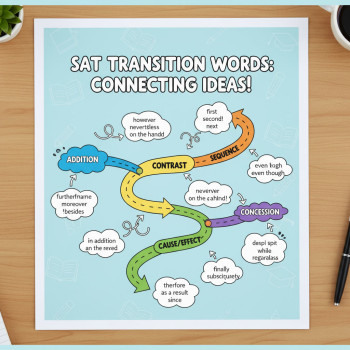Why keeping score matters more than you think
If you’re preparing for the Digital SAT, you’ve probably heard a thousand variations of the same advice: practice, practice, practice. That’s true—but practice without measurement is like running on a treadmill without watching the distance: you’re working hard, but you don’t know whether you’re getting closer to your goal. Tracking your SAT score progress is one of the simplest, most powerful ways to turn effort into confidence. When done right, it does more than show numbers on a page—it builds momentum, sharpens focus, and keeps your motivation steady through the long haul.
Not just vanity metrics: why progress matters
There’s a difference between practicing to feel busy and practicing to improve. Tracking transforms nebulous effort into clear feedback. You can see where your strengths are improving, where your weak spots remain, and whether the study methods you’re using are actually working. Small, visible wins—an extra point on a practice section, a faster pace on reading passages—compound into sustained progress. That compounding effect is the secret ingredient behind many big score jumps.
How tracking boosts motivation: three psychological levers
Tracking taps into human psychology in reliable ways. Here are three mechanisms that explain why charts and numbers can change behavior for the better.
1. Progress breeds persistence
Seeing progress—even incremental—gives the brain a dopamine reward. It validates your effort and makes you more likely to return to studying. That one additional point on a practice test becomes proof: your work matters.
2. Milestones make goals manageable
Large goals (e.g., “score a 1400”) can feel distant and overwhelming. Breaking them into smaller milestones—section scores, topic goals, or weekly improvements—creates a series of achievable steps. Each milestone is a celebration, and those celebrations keep momentum alive.
3. Feedback lets you optimize
Without tracking, you might spin your wheels on ineffective strategies. A log of practice results helps you test hypotheses—did a different approach to algebra problems help? Did timed reading drills improve your stamina?—and then refine your methods based on evidence instead of guesswork.
What to track: the practical checklist
Not all data is equally useful. Here’s a practical checklist for what to record so your tracking stays actionable and uncluttered.
- Full-length practice test scores (total and sections)
- Section breakdowns by question type (e.g., algebra, problem solving, command of evidence, words in context)
- Timing data (how long you took per passage or problem set)
- Error categories (careless mistakes, content gaps, timing errors, misreading)
- Study activity logs (what you did that day and for how long)
- Subjective notes (energy level, distractions, confidence)
Example: a minimal weekly tracking template
Each week, record one practice test or two focused section blocks. Keep it short and consistent—consistency beats perfection.
- Practice/Test name and date
- Total score and section scores
- Top 3 mistake types
- One action item for the next week (e.g., “30 minutes targeted algebra practice daily”)
Sample table: turning results into insight
Below is a compact example of how you might present four weeks of practice-test data in a study log. This helps you spot trends at a glance.
| Week | Test | Total Score | Reading & Writing | Math | Top Mistake Types | Next Week’s Focus |
|---|---|---|---|---|---|---|
| 1 | Official Practice Test 1 | 1060 | 510 | 550 | Timing on passages; algebra basics | Timed reading drills; algebra review |
| 2 | Timed Section Mix | 1100 | 530 | 570 | Careless errors; multistep problems | Accuracy exercises; work-back technique |
| 3 | Full-Length Practice 2 | 1140 | 560 | 580 | R&W: vocab-in-context; Math: ratios | Vocab strategy; targeted ratios practice |
| 4 | Diagnostic + Review | 1180 | 590 | 590 | Improved timing; still a few careless slips | Timed sections with forced check step |
This kind of table makes patterns obvious. Over the month above, the student improved total score by 120 points, with steady reading gains and an earlier faster math improvement—clear evidence that the chosen tactics worked.
How to visualize progress for maximum motivation
A table is great for details, but a simple chart can be more motivating. Plot your total score on a line graph, add section scores as separate lines, and include milestone markers (e.g., target score, test date). Visual slope matters: a steadily rising line feels encouraging even if the week-to-week change is small.
Two visualization tips
- Use a moving average (3–4 tests) to smooth out random noise so you focus on real trends, not one bad day.
- Add annotations for big changes: note when you switched a study method, started tutoring, or got a lot of sleep before a test. These help you connect cause and effect.
Common tracking pitfalls (and how to avoid them)
Tracking isn’t a magic pill. If you fall into these common traps, it can hurt motivation rather than help.
Pitfall 1: Chasing a single number
Fixating only on the total score makes you blind to the underlying skills. If you only look at totals, you might miss that your math is improving while reading stagnates. Track section and question-type detail too.
Pitfall 2: Recording without reflecting
Collecting data without analysis is busywork. Every log entry should end with one actionable takeaway: what will you do differently next week?
Pitfall 3: Overreacting to one test
Some tests are outliers—bad sleep, illness, or an unusually hard test date. Use a series of results to judge progress, not a single snapshot.
How to use errors as fuel, not as shame
Errors are gold. The smart student treats each mistake as data that tells a story: was it content, timing, or careless? Create an error taxonomy that you can review weekly and convert into targeted practice blocks.
Sample error taxonomy
- Content gap: didn’t know a concept (e.g., function notation)
- Process error: misapplied method or formula
- Timing/completion: ran out of time or guessed blindly
- Careless mistake: misread question or arithmetic slip
When you tag mistakes like this in your tracking sheet, you start to see which category dominates—and therefore which study strategy will have the biggest payoff.
Daily and weekly routines that complement tracking
Tracking is the map; study routines are the travel plan. Here are some small, repeatable routines that pair naturally with a score log.
- Daily: 30–45 minutes of focused practice on a single skill tied to your tracking action item.
- Weekly: one timed full section or a full-length practice test every 7–10 days.
- Reflection: 15 minutes after a test to log results, tag errors, and choose one improvement for next week.
- Accountability: share a monthly progress snapshot with a teacher, parent, or tutor.
How tutoring accelerates progress—and when to bring it in
Many students plateau because they repeat the same ineffective strategies. A smart tutor helps you diagnose the bottleneck—content gaps, poor timing, or strategy—and design experiments to fix it. If you’ve tracked for a month and see little movement despite consistent work, that’s usually the signal to get specialized help.
That’s where personalized tutoring—like Sparkl’s 1-on-1 guidance—can slot in naturally. Expert tutors provide tailored study plans rooted in your tracking data, identify the highest-leverage activities, and use AI-driven insights to speed up the learning loop. Instead of random practice, you get a plan that matches your unique pattern of strengths and weaknesses, which means each hour you study becomes more effective.
Real student example: turning small wins into a big jump
Meet Maya (a composite example based on common student journeys). She started with three practice tests over six weeks and logged a total average of 1030. Her tracking showed math improving faster than reading, and many of her reading misses were timing-related—she rushed passages and guessed on the last few questions.
Maya’s plan was surgical: two weeks of timed reading practice with a forced-check routine, one math concept review per day, and weekly full-length tests. She also began short, focused review sessions after each practice test to tag and correct mistakes. Over eight weeks she moved from 1030 to 1180. The tracking made small wins visible—faster passage pace, fewer last-minute guesses—and that visibility sustained her effort through plateaus.
Putting it all together: a 6-week tracking plan
Here’s a practical plan you can start this week. It combines measurement, reflection, and targeted practice.
- Week 1: Baseline. Take an official practice test. Record total, section scores, and error tags.
- Week 2: Focus. Pick the single biggest error type and do daily practice targeting it. Do a timed reading section mid-week.
- Week 3: Test again. Take a full practice test. Compare trends; use a moving average to judge progress.
- Week 4: Intensify. Introduce one new tactic (e.g., process of elimination strategy, structured checking routine). Track carefully.
- Week 5: Simulate test conditions. One full test under strict timing, reduced distractions, and test-like breaks.
- Week 6: Review and plan. Look at the six-week trend. Set a next-phase goal (e.g., +40 points in the next six weeks) and pick one or two tactics for continued practice.
Where Sparkl can help in this plan
If you want to accelerate the loop, a short block of 1-on-1 tutoring can help you choose the highest-leverage actions in Week 2 or Week 4. Tutors review your tracking sheet, identify limiting factors, and provide tailored study plans that complement your logged data. Combining your tracking with expert feedback is a fast path to consistent improvement.
Final checklist: tracking tools and habits
Before you go, here’s a portable checklist to make tracking simple and sustainable.
- Pick a single place to store data (spreadsheet, notebook, or app).
- Record immediately after every full practice test.
- Tag errors by category and pick one weekly action item.
- Plot a simple line graph of total score and section scores (weekly or biweekly).
- Use a 3–4 test moving average to judge real progress.
- Consider short bursts of 1-on-1 tutoring when progress stalls—tutors can tailor plans based on your tracking data.
Parting thought: make progress visible, and motivation will follow
Preparing for the Digital SAT is both a skills game and a psychology game. Tracking turns ambiguity into clarity, builds momentum through visible wins, and helps you spend your study time where it matters most. The simple act of logging a score and picking one next step after each practice session turns random effort into a deliberate improvement system.
If you want to pair measurement with tailored guidance, consider combining your tracking routine with short blocks of personalized tutoring. Services like Sparkl offer 1-on-1 guidance, tailored study plans, expert tutors, and AI-driven insights that can amplify what you see in your tracking data—so every hour of study moves you closer to the score you want.
Start today: take a practice test, open a fresh spreadsheet or notebook, and make your first log entry. The first point you earn isn’t just a number—it’s evidence that you’re on the way up.















No Comments
Leave a comment Cancel